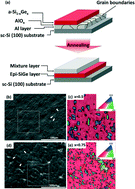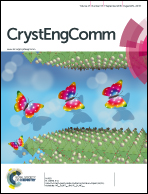Hetero-epitaxial growth of stoichiometry tunable Si1−xGex film via a low temperature aluminium-induced solid phase epitaxy (AI-SPE) process†
Abstract
A novel process of aluminum-induced solid-phase epitaxy (AI-SPE) is used to fabricate a hetero-epitaxial Si1−xGex (epi-SiGe) film on an sc-Si (100) substrate at relatively low temperatures (lower than 450 °C) using a 1/4 × 4′′ wafer. The stoichiometry of Ge in the epi-SiGe film can be easily tuned in the AI-SPE process by controlling the annealing temperature and the Ge fraction (x) of the initial a-Si1−xGex layer. The stoichiometry and epitaxial relationship of the epi-SiGe film were verified by grazing incidence X-ray diffraction (GI-XRD) and transmission electron microscopy (TEM). The AI-SPE mechanism is directly verified by in situ heating TEM. Based on the experimental results, it is concluded that the AI-SPE mechanism for the epi-SiGe film can be divided into four steps: (a) initial stage; (b) formation of a-Si1−xGex free atoms and diffusion along Al grain boundaries to the sc-(100) substrate surface; (c) nucleation of crystalline Si1−xGex at the surface of the sc-Si (100) substrate; and (d) crystal growth and layer exchange.


 Please wait while we load your content...
Please wait while we load your content...